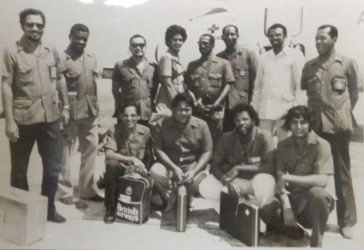The Guyana National Rifle Association (Guyana NRA) will celebrate its 150th anniversary in October (9th -15th) this year with the hosting of the West Indies Fullbore Shooting Championships at the Timehri Rifle Ranges.
This is part one of a series on the history of the association as compiled by Ms. Margaret Smith from the commencement of shooting in the 19th Century to 1992.
Subsequently, the history of the remaining years was put together by Mahendra Persaud (Fullbore Captain), Ransford Goodluck and Ryan Sampson (Secretary of the Association) with the assistance of a few members of the Guyana NRA.
Part One
Introduction
Rifle shooting as a competitive sport is not new to Guyana. It dates back to the early 1790’s and was formalised in 1865 with the establishment of the Demerara Rifle Club. The latter became the British Guiana Rifle Association and today is known as the Guyana National Rifle Association.

The Demerara Rifle Club was formed by a Regiment of British Soldiers stationed in the then British Guiana, and was coordinated by the succession of British Troops stationed in British Guiana thereafter.
From the formation of the Rifle Club to Independence, the organisation responsible for the running of the club varied, namely: British Garrison (1878), British Guiana Militia Volunteer Force (1891), British Guiana Volunteer Force and the Guyana Defence Force (1966).
Membership, categorised under individual and block members was open to all Officers, Non-Commissioned Officers and men on the active list of all local forces. Eventually it expanded to all residents in Guyana over the age of fifteen (15) other than members of the active Force.
Initially, competitions were of two types- smallbore and fullbore. However, there was a lull in smallbore competition for several years which resulted from a shortage of ammunition. Happily, in 1992, the smallbore competition was re-introduced.
Originally, shooters, depending on their shooting ability, were categorised as ‘A’, ‘B’ or ‘C’ class, with ‘A’ class being the highest. However, if a shooter was selected and participated in an international competition, he immediately became a senior shooter and attained an ‘X’ class rating.
In keeping with the other countries, the local association now uses two classes: ‘A’ class which identifies shooters who are selected and participate in an international competition. They are referred to as senior shooters. ‘B’ class identifies shooters who have not yet competed at international competitions. They are also referred to as junior shooters.
At international competitions, shooters are categorized ‘O’ or ‘X’ class depending on their shooting ability. ‘X’ class is higher. The association is entirely responsible for the selection of teams competing in local and international meetings. As a result, teams competing do so in the name of Guyana or the West Indies and not in the name of any particular club or organisation.
Interest in the sport is still a far cry from what is desired but from the inception of the sport, the Guyanese standard of rifle shooting has been exceptional. There have been outstanding performances in local and international competitions.
The association, boosted by past greats and current shooters, has maintained high standards, while a pool of talent is being developed to carry on the tradition.
The Guyana NRA has recorded wins for every trophy put up for competition among Guyana, Barbados, Trinidad, Jamaica and effective 1989, Bermuda. These trophies include, Anchor Challenge Cup (Benson and Hedges Trophy), Martinez Shield and Swettenham Trophy to name a few.
The association also competed and recorded wins for the Duke of Gloucester Trophy, which is controlled by the National Rifle Association (NRA) Great Britain and competed among other nations at Bisley – the Mecca of rifle shooting in world.
Though female membership was still infrequent, Guyana boasted a few greats. They not only made a name for themselves locally, competing among the males, but also managed to be members of teams which competed for the Anchor Challenge Cup and the Duke of Gloucester Cup at Bisley.
Members of the association won individual events and were awarded prizes, medals and cups.
Initially, shooting took place at the Thomas Lands range. Veteran marksmen claimed the windy situation at the Thomas Land range was responsible for the range being classified as the best in the Caribbean. Some even said that it was better than Bisley.
On the 7th July, 1964, rifle shooting was temporarily suspended because the rifle range was taken over by the Military and it is now part of Camp Ayanganna. An ‘Arm Call-in-Order ‘was subsequently issued by the Governor and ever since, when not in use, the rifles must be lodged at Police Stations or Military Armouries for safe keeping.







